When Christopher Columbus first reached the Bahamian Islands in 1492, he encountered a native culture completely unfamiliar to Europeans. Native Bahamian foods were strange and surprising to Columbus and his crew. Columbus and early colonizers adopted Bahamian foods, while simultaneously introducing European foods to the Americas. As two vastly different cultures converged, a native population was all but destroyed, as a brand new food culture developed.
During the 15th and 16th centuries, a number of European countries financed sailing expeditions in hopes of finding uncharted lands, gold and other riches. In the early 1400s, the Portuguese backed a successful expedition to Asia and Africa. When the ships returned with gold, spices, and slaves (incomprehensibly, humans of color were traded like a commodity), other countries joined in global exploration.
For the previous century, Spain had been occupied with political affairs concerning the Jewish and Muslim population. In 1492, King Ferdinand and Queen Isabella issued an edict (known as the Alhambra Decree) decreeing that all Jews should be driven out of the kingdom. That same year, a young Genoese man named Christopher Columbus (known in Spain as Cristóbal Colón) embarked on an exploratory voyage to the Far East.
Interesting Side Note: It is now theorized that Christopher Columbus may have in fact been a Jew living in hiding—known at the time as a converso. Read more here.
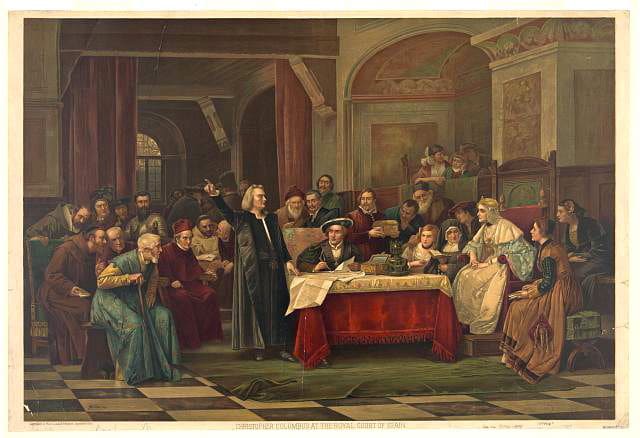
Christopher Columbus at the royal court of Spain, presenting his request to Queen Isabella I and Ferdinand V and a gathering of courtiers. Library of Congress.
Columbus, a self-taught scholar and voracious reader, had studied math, astronomy and cartography. He told the Spanish monarchs that he strongly believed he could reach Asia from Europe by sailing west across the Atlantic. After lobbying the Spanish court for two years, his trip was finally financed.
Columbus embarked on the first of what would be four voyages, reaching the Bahamian Islands on October 12, 1492. He discovered a thriving indigenous people, the Taino (a tribe of the native Arawaks), who drew sustenance from colorful native crops, fish, and game. Maize, beans, squash, and seafood were central components of the native diet. In one of his logs, Columbus described a native meal, which was comprised of fish and “bread which tasted exactly as if it were made of chestnuts.”
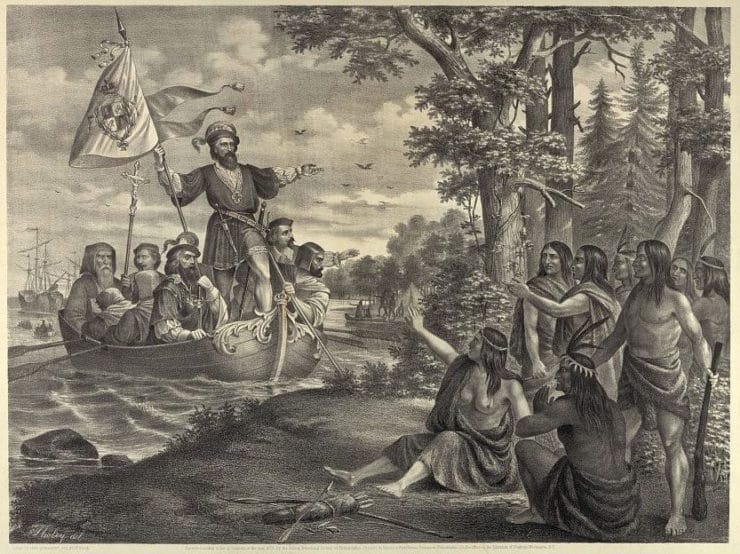
Landing of Christopher Columbus in America. Library of Congress.
Fish and wild fowl (turkey) were the main sources of meat. Other regional crops included cacao (chocolate), maize, potato, tomato, capsicum, peppers, cassava, pumpkins, and groundnuts (peanuts). Tropical fruits enhanced the native diet, such as pineapple, avocado, guava, and papaya. Most of these foods were new and unfamiliar to Columbus and his crew. In Hispaniola, the first settlement in the New World, the native foods of the Taino tribe became an important source of sustenance to the European colonizers.
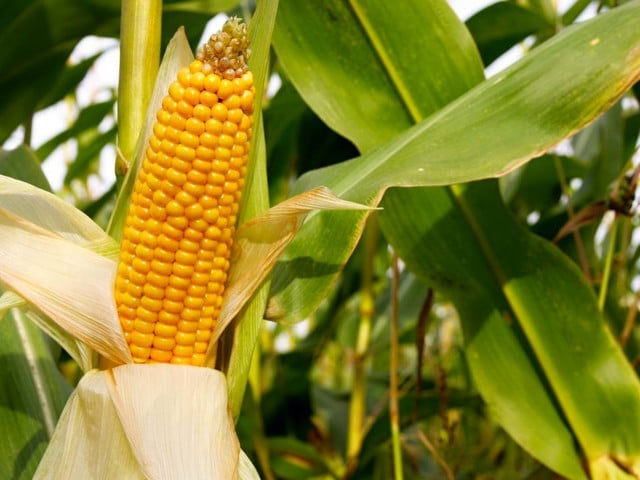
Maise was the main native crop of the indigenous Taino tribe.
In the early days of Hispaniola, many European colonizers died due to disease. At the time, their demise was largely attributed to malnutrition. While European settlers enjoyed native foods made with maize and cassava, they believed that somehow their bodies were not equipped to handle these foods. On subsequent voyages to the New World, Columbus brought with him European foodstuffs that would drastically change the cultural and ecological landscape of the Americas.
While European colonizers had difficulty adjusting to the new food culture of the Americas, their arrival took an even greater toll on the native landscape. Before Columbus came to the New World, it is estimated that some 250,000 natives Arawaks lived on the Bahamian islands. By the early 1500’s, less than 15,000 remained, most having perished after exposure to European diseases (for which they had no immunity).
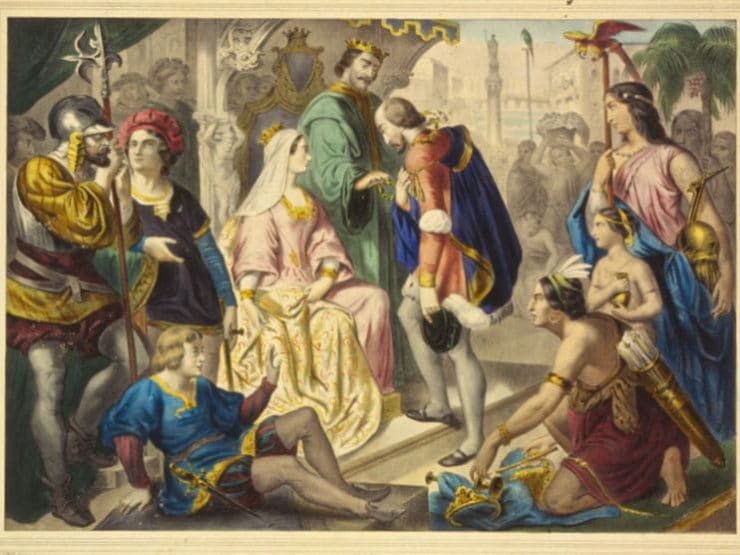
Retour de Christophe Colomb – Christopher Columbus being greeted by King Ferdinand and Queen Isabella on his return to Spain. Vve. Turgis, éditeur. Library of Congress.
On Columbus’ second voyage he brought wheat bread, as well as radishes, chickpeas, and melons. Livestock came from Europe, including horses, cattle, pigs, sheep, goats, and chickens. Over time, new crops were introduced to the Americas, including wheat, rice, barley, oats, coffee, sugar cane, citrus fruits, melons and Kentucky bluegrass.
The introduction of wheat was of particular significance. For thousands of years, bread had been a central part of the European diet. Wheat was not indigenous to the Americas, where maize was the native grain. In the first few decades of colonization, European settlers imported goods like bread, wine, olive oil and certain meats. Over time, wheat and other European foodstuffs were cultivated and grown in the Americas.
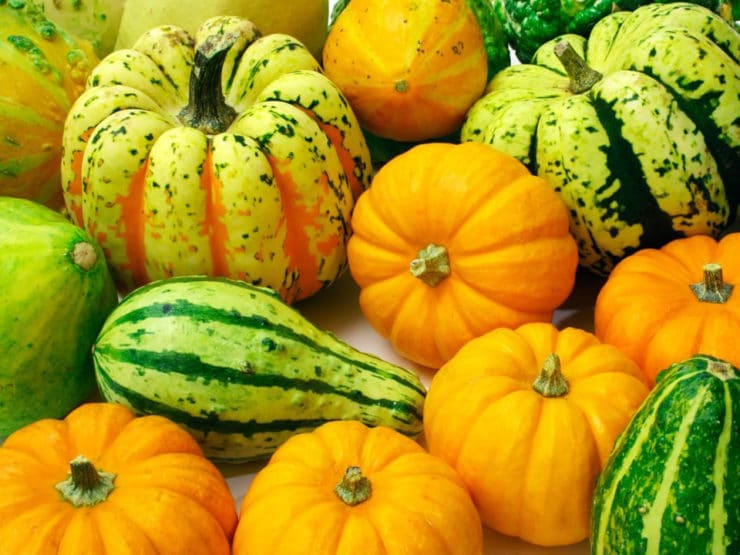
When all is said and done, the Spanish hoped to Europeanize the native populations of the islands of the Caribbean and convert them to Catholicism. By attributing the deaths of European settlers to native foods, they were buoying their argument for the superiority of European food and, simultaneously, European values. The truth is, the arrival of European settlers devastated a thriving native population and landscape. This strange and sad intersection of native American foods and European crops gave rise to a brand new food culture.
RESEARCH SOURCES
Andrews, Jean (1993). “Diffusion of MesoAmerican Food Complex to Southeastern Europe.” Geographical Review, Vol. 83, No. 2 (Apr., 1993), pp. 194-204
Bergreen, Lawrence (2011). Columbus: The Four Voyages. Viking, New York, NY
Burkholder, Mark A. and Johnson, Lyman L. (2003). Colonial Latin America. Oxford University Press, 1994, 2nd ed., New York, NY
Columbus, Christopher and Cohen, J.M. (Translator) (1992). The Four Voyages: Being His Own Log-Book, Letters and Dispatches with Connecting Narratives. Penguin Classics, New York, NY
Cook, David Noble (2002). “Sickness, Starvation and Death in Early Hispaniola.” The Journal of Interdisciplinary History, Vol. 32 No. 3 pp. 349-386.
Divina, Fernando and Marlene (2004). Foods of the Americas: Native Recipes and Traditions. Ten Speed Press, Berkeley, CA
Earle, Rebecca (June 2010). “If You Eat Their Food… Diets and Bodies in Early Colonial Spanish America.” American Historical Review, Vol. 115 No. 3, pgs. 688-713. University of Chicago Press, Chicago, IL.
Kiple, Kenneth F. (2007). A Moveable Feast: Ten Millennia of Food Globalization. Cambridge University Press, New York, NY.
Mann, Charles C. (2005). 1491: New Revelations of the Americas Before Columbus. Vintage Books, New York, NY.
Mann, Charles C. (2011). 1493: Uncovering the New World Columbus Created. Knopf, New York, NY.
Greogory McNamee. Movable Feasts: The History, Science and Lore of Food. Westport, Ct.: Praeger, 2007.
Milioni, Stefano (1992). Columbus Menu: Italian Cuisine After the First Voyage of Christopher Columbus, 1492-1992. Italian Trade Commission, New York, NY.
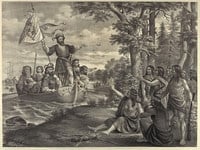


<>
Your assertion that Europeans considered some native foods barbaric “simply because they were unfamiliar” struck me as unlikely, and unfairly pejorative of the Spaniards. Looking up your sources (thanks for providing them!), I found a far more detailed explanation.
From “If You Eat Their Food…”:
Europeans looked with disdain on many of the things eaten by Amerindians, and on occasion drew explicit comparisons between the incivility of the food and that of the people who ate it…. The consumption of insects attracted particular scorn. “They eat hedgehogs, weasels, bats, locusts, spiders, worms, caterpillars, bees, and ticks, raw, cooked, and fried. Nothing living escapes their gullet, and what is all the more amazing is that they eat such bugs and dirty animals when they have good bread and wine, fruit, fish and meat,” remarked the chronicler Francisco López de Gómara in 1552, after the Spanish had introduced their superior foodstuffs. As Anthony Pagden observed, the inability to distinguish between the edible and the inedible was a sure sign of barbarism. Cannibalism was of course the clearest example of such a category mistake….
Clearly, Europeans had more substantial reasoning behind their dismissal of some Amerindian food choices than “simply because they were unfamiliar”.
Actually, the section you chose proves my point. Treating food sources like “bugs and dirty animals” as an object of scorn is cultural bias. There are many cultures that consume insects as a regular protein source, and while it might seems squeamish or unfamiliar to most of us, it is no less “barbaric” than eating slaughtered cow’s meat. Gómara’s opinion that the native Amerindians had an “inability to distinguish between the edible and inedible” and that the Spaniards considered their own foodstuffs “superior” is clearly a biased judgement.
As for the cannibalism, it is very likely that reports of cannibalism are overblown, if not completely inaccurate. Queen Isabella decreed that slaves could not be sold by her subjects unless they were deemed cannibals– so there was financial incentive for natives to be labeled as cannibals, even when they were not.
Native Americans were not cannibalistic. The Caribs where branded canibalistic, because the Catholic Church explicately gave them permission to enslave ONLY CANNIBALS! That was just an excuse to dispossess and enslave tribes that fought back against the European Mass hordes who invaded their lands. Cannibalism was one of the biggest taboos in most Native American tribes especially the Caribbean people. The Europeans were the ones committing cannibalism in Jamestown because instead planting crops and working the lands, they were digging holes looking for gold. They thought they could just beg of the Powhatans, or steal their food stores because they had did it before. Well this time they out of luck winter came and the whole town was starving. They ended up killing family members or digging rotted Indian corpses in burial grounds. Most of them died, and the cannibals has to wait until their own supply ships came in. The Donner party is another famous example of the stupidity and treachery of the European invaders. They ended stuck in the mountains eating their own dead, and when two brave Native Miwok men came to bring supplies, they saw what the colonists did and were disgusted by the site. They were not even trying to hide at this point. The got scared and when they left because the man they came warned them they they were going to be murdered for food. These brave men were hunted down and murdered by crazed and treacherous European cannibals!! Native Americans from the Caribbean’s know how to fish the waters, plant their crops, and hunt for game. They had lives off the land for thousands of years, so they did not need to resort to cannibalism, unlike the newly arrived Euros. Some tribes like the Aztec practiced ritualized cannibalism , but that it was mostly symbolic in gaining the bravery of a foe by eating a piece of his heart. This is not the same as eating somebody because you do not know what foods to eat, or being to lazy and greedy to plant and hunt your own food.
Very useful article.
It was really helpful
Great article.
I came across your blog because i was actually searching for blogs about sailing in central america (we actualy run a sailboat charter business in Panama), and even though it’s not exactly what i was looking for, i’ve found your article about Columbus very interesting.. It’s clear and pleasant to read and It’s always nice to learn something new !.. 🙂 So Thank you
Thank you for this post, I home school my kids and I plan to share it as part of our Columbus unit. I must admit I’ve spent the past on your site, so much great information here. And I love the vintage recipes. Keep up the great work.
I didn’t know about Columbus and the converso theory, really interesting tidbit!
That Columbus was Genoese is now considered extremely unlikely, except for those with vested political interests (namely, the Spanish, who prefer a Columbus Genoese than one with true origins). He was not a jew either. In fact, that his true origins are not known (Genose, jew, a woman, an arab, etc) even though he was one of the most important people of his time, is very telling.
Spanish censorship was very active in destroying all original Columbus’ writings. Columbus was Catalan. His real surname is Colom (same meaning (pigeon) as the Italian ‘Colombo’.
I he had been a ‘Colombo’, how and why did the Spanish called him ‘Colon’? Some one explains to me that simple fact please…
Equally wrong is the assertion that the voyage was funded by the Queen (with her jewels right?) It was funded by Lluis de Santangel, a treasurer of the KING of Aragon, Ferdinand.
very interesting
Great information … I always love visiting your site 🙂
Wonderful post Tory….so very interesting!! Thanks for sharing